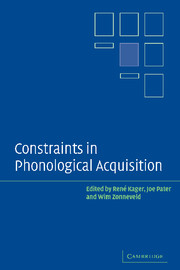Book contents
- Frontmatter
- Contents
- List of contributors
- Abbreviations
- Preface
- 1 Introduction: constraints in phonological acquisition
- 2 Saving the baby: making sure that old data survive new theories
- 3 Markedness and faithfulness constraints in child phonology
- 4 Input elaboration, head faithfulness, and evidence for representation in the acquisition of left-edge clusters in West Germanic
- 5 Phonological acquisition in Optimality Theory: the early stages
- 6 Syllable types in cross-linguistic and developmental grammars
- 7 Bridging the gap between receptive and productive development with minimally violable constraints
- 8 Learning phonotactic distributions
- 9 Emergence of Universal Grammar in foreign word adaptations
- 10 The initial and final states: theoretical implications and experimental explorations of Richness of the Base
- 11 Child word stress competence: an experimental approach
- Index of subjects
- Index of names
6 - Syllable types in cross-linguistic and developmental grammars
Published online by Cambridge University Press: 22 September 2009
- Frontmatter
- Contents
- List of contributors
- Abbreviations
- Preface
- 1 Introduction: constraints in phonological acquisition
- 2 Saving the baby: making sure that old data survive new theories
- 3 Markedness and faithfulness constraints in child phonology
- 4 Input elaboration, head faithfulness, and evidence for representation in the acquisition of left-edge clusters in West Germanic
- 5 Phonological acquisition in Optimality Theory: the early stages
- 6 Syllable types in cross-linguistic and developmental grammars
- 7 Bridging the gap between receptive and productive development with minimally violable constraints
- 8 Learning phonotactic distributions
- 9 Emergence of Universal Grammar in foreign word adaptations
- 10 The initial and final states: theoretical implications and experimental explorations of Richness of the Base
- 11 Child word stress competence: an experimental approach
- Index of subjects
- Index of names
Summary
Introduction
In this chapter we consider syllable types in acquisition, language typology, and also in a third dimension, namely production frequency in the language surrounding the language learner.
In Optimality Theory (OT) (Prince and Smolensky 1993) both language acquisition and language typology can be accommodated. The basic assumption is that constraints are universal, but that the rankings of these constraints are language particular. For language typology the idea is that different rankings reflect different (possible) languages. For acquisition the idea is that the learner needs to acquire the language-specific ranking of his mother tongue. The assumption here, like in most otherwork on acquisition to date (Gnanadesikan this volume, Hayes this volume, Davidson et al. this volume, Prince and Tesar this volume), is that structural constraints initially outrank faithfulness constraints. The grammar in this state prefers structurally unmarked outputs to faithful ones. By promoting faithfulness constraints in the ranking, or by demoting structural constraints, the outputs can become more marked and more faithful to their inputs.
What is the expected relation between language typology and language acquisition? Concentrating here on syllable types, languages can be structurally marked or unmarked with respect to the structural constraints that refer to syllable type: Onset, No-Coda, *Complex-Onset, and *Complex-Coda. A language is structurally unmarked with respect to a structural constraint when such a constraint dominates faithfulness constraints, and it is marked when such a constraint is dominated by faithfulness constraints.
- Type
- Chapter
- Information
- Constraints in Phonological Acquisition , pp. 204 - 218Publisher: Cambridge University PressPrint publication year: 2004
- 26
- Cited by



